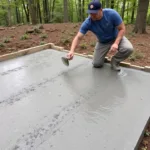Creating the color brown with crayons might seem simple, but there’s actually a surprising amount of nuance involved. It’s not just about grabbing a brown crayon—you can achieve a wide range of brown hues by mixing different colors together. This allows for artistic exploration and the creation of truly unique artwork. Let’s delve into the fascinating world of color mixing and discover how you can make brown with your crayons.
Mixing colors like creating a delicious recipe, and brown is no exception. You can achieve beautiful shades of brown by combining primary colors with black, or even by blending complementary colors together. The possibilities are endless! Curious about other color combinations? Check out how to wrap a coloring book for a fun project.
Mastering the Art of Brown: Primary Colors and Black
One of the most straightforward methods for making brown involves combining the primary colors—red, yellow, and blue—with a touch of black. The ratio of each color will determine the final shade of brown. For instance, more red will result in a reddish-brown, while adding more blue will create a cooler, more subdued brown.
- Start with red and blue: Combine approximately equal parts of red and blue to create purple.
- Introduce yellow: Gradually add yellow to the purple mixture. You’ll notice the color shifting towards brown.
- Add a touch of black: Carefully introduce small amounts of black to darken the mixture and achieve the desired shade of brown.
Exploring Complementary Colors for Rich Browns
Complementary colors, located opposite each other on the color wheel, offer another avenue for creating brown. For example, mixing orange and blue, or red and green, can yield beautiful, earthy browns. This approach provides a more nuanced and complex brown than simply adding black to primary colors.
- Orange and Blue: Start with a vibrant orange and gradually add small amounts of blue.
- Red and Green: Alternatively, combine red and green in similar proportions, adjusting the amounts to achieve your desired shade of brown.
 Mixing Complementary Colors for Brown
Mixing Complementary Colors for Brown
If you’re interested in exploring more with color mixing, check out what do all colors mixed together make? This article will expand your understanding of color theory.
What Crayon Colors Make Brown? A Deeper Dive into Combinations
Several specific crayon colors can be mixed to create beautiful shades of brown. Experimenting with these combinations can be a fun way to discover new and unique browns.
- Red and Green: This classic combination yields a rich, natural brown.
- Orange and Blue: Similar to the complementary color approach, this pairing creates a slightly warmer brown.
- Yellow, Blue, and a touch of Red: This trio can create a lighter, more golden brown.
- Purple and Yellow: Combining these colors offers a surprisingly effective way to achieve a deep, almost chocolatey brown.
Thinking about coloring eggs for Easter? Here’s a helpful guide: can you dye easter eggs with gel food coloring.
Tips and Tricks for Creating the Perfect Brown
- Layering: Applying layers of different colors can create depth and dimension within your brown hues.
- Pressure: Varying the pressure you apply while coloring will affect the intensity of the color. Lighter pressure results in a softer, more translucent brown, while heavier pressure creates a bolder, more opaque effect.
- Blending: Use a blending stump or a cotton swab to smoothly blend the colors together, creating a seamless transition between shades.
“The beauty of working with crayons lies in their simplicity and versatility. With a little experimentation, you can unlock a vast spectrum of colors, including an array of beautiful browns,” says renowned color expert, Amelia Hues.
Want to know more about skin tones? Check out what is the color of flesh.
Conclusion
Creating brown with crayons is a journey of artistic exploration. By understanding the interplay of colors, you can achieve a wide range of brown hues, adding depth and richness to your artwork. Whether you prefer the simplicity of primary colors and black, or the complexity of complementary color combinations, there’s a method for every artistic vision. So, grab your crayons and embark on your own color mixing adventure! How do you make the color brown with crayons? You now have the answer, so start experimenting!
FAQ
- What are the primary colors?
- What are complementary colors?
- How do I make light brown with crayons?
- How do I make dark brown with crayons?
- What other colors can I make by mixing crayons?
- Can I use other mediums to blend crayons?
- Where can I find more information about color theory?
Scenarios for using Brown
- Drawing trees and branches
- Coloring animals like bears and dogs
- Creating earthy landscapes
- Depicting wooden objects
Have you ever wondered, can you use gel food coloring for eggs? It might be an interesting alternative to traditional dyes.
Further Exploration
Explore other color mixing techniques on our website to expand your artistic horizons.
Need help with your color projects? Contact us at Phone: 0373298888, Email: [email protected] or visit us at 86 Cầu Giấy, Hà Nội. We have a 24/7 customer support team ready to assist you.
